|
THE FAIRFORD BRANCH LINE |
|
|
|
CARTERTON |
|
The site of Carterton station (SP286048) can be viewed from the nearby road overbridge which carries the minor road from Black Bourton to Elmwood House (until recently a
mushroom farm) and the southern boundary of RAF Brize Norton. The station building survives complete with its awning, although in 1980 it received a rustic timber cladding (see photo). Recently planted trees make it
increasingly difficult to see from the bridge (impossible in the summer) but please do not trespass on the track, as it is on private property.
|
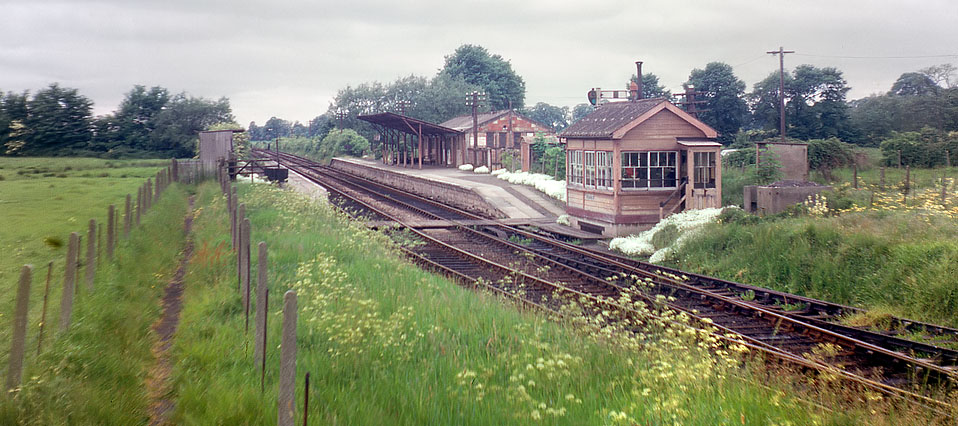 |
|
Carterton station pictured in June 1962. This photo is taken from the footpath leading to the down platform from the Carterton to Black Bourton road. The rural nature of the
surroundings is immediately evident. Nowhere near Carterton!
Martin Loader Collection
|
|
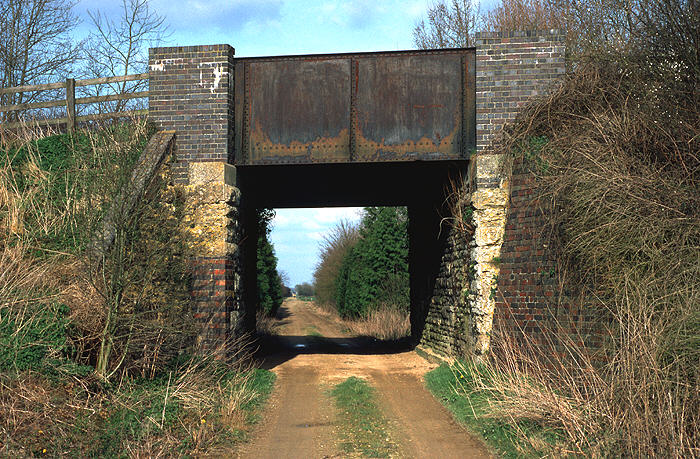
|
|
The bridge near Carterton station (seen here on 3 April 1983) carries the road that originally linked Black Bourton (the village that Carterton station is actually nearest to)
to Carterton. In 1951 the nearby Brize Norton airfield was handed over to the USAF and in preparation for its new role as home for giant B-36 & B-47 nuclear bombers, the runway was extended to nearly two miles in
length, cutting through the Carterton to Black Bourton road. Today a footpath that skirts the perimeter fence past the end of the runway still links the two severed ends of the road. This bridge is one of the standard EGR
designs, with a 12 ft 8 in span, although with more substantial steel sides than some of the other survivors. It also shows the curious random mix of local Cotswold stone and brick which was a feature of a number of the
EGR bridges. The retaining wall on the right is all of stone, while on the left stone is interspersed with sections of brick, the right hand wing wall is all brick, while
on the right stone is used with brick patches!
Resting on concrete lintels, the deep steel parapet is obviously a later addition, which accounts for the more uniform blue engineer's bricks used for the parapet ends.
Martin Loader
|
 |
Close inspection of the steel parapets at Carterton reveals their origin - the Horsehay Ironworks in Shropshire. Even in 2022 the rust hadn't totally obscured the
wording.
Martin Loader
|
|

|
| 74xx 0-6-0PT 7411 arrives at Carterton on 2 June 1954 with the 18:18 Oxford to Fairford service. Either there is something odd about the profile of the second coach, or it is
leaning to the right as it negotiates the start of the loop! To the right of the loco, just behind the pile of platform coping stones is the gate leading to the path from the road. Hugh Ballantyne |
|
An interesting pair of pictures looking east from the road overbridge near Carterton station. On the right, in what is obviously a pre-war picture, an unidentified loco
approaches what was then just a bridge near the village of Black Bourton, as neither Carterton station, nor RAF Brize Norton, had yet been built. In the early 1960s (below) the view had changed somewhat, with the
construction of Brize Norton airfield, which at this time was under USAF control. Six Boeing B47 nuclear bombers can be seen in the background. Obviously the tree had to go, as it was in line with one of the runways! Note
also the dwarf telegraph poles bordering the second field.
David Oakey Collection & Colour Rail |
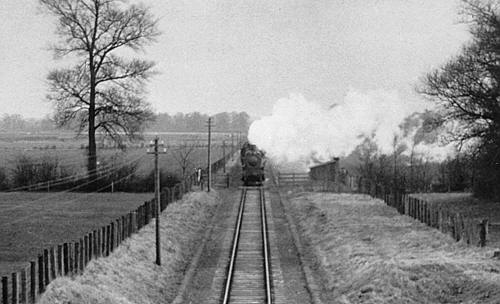 |
|
Carterton station was the final station on the line to be built, opening to passengers on 2 October 1944, although the loop had opened a couple of months previously. Because
of the proximity of Brize Norton and Alvescot, no goods facilities were provided. The station building was constructed of concrete blocks with an asbestos roof, very reminiscent of the many military buildings constructed
around the same time, indeed it was largely as a result of the proximity of RAF Brize Norton that the station was constructed. During the Second World War, large numbers of military personnel were handled at the station. A
very large canopy was provided, built from rails and asbestos sheeting. A basic shelter was provided on the down platform.
|
 |
|
22xx 0-6-0 2221 pulls away from Carterton station on a sunny evening in late May or early June 1962 with the 18:10 Fairford to Oxford train, the last up train of the day.
This view gives a clear view of the signal box and station building from the north side. Note that what was formerly allotments (see picture below) has now become very overgrown. However, the solitary pig in the field
on the left seems to be a permanent fixture! Peter Reeves
|
|
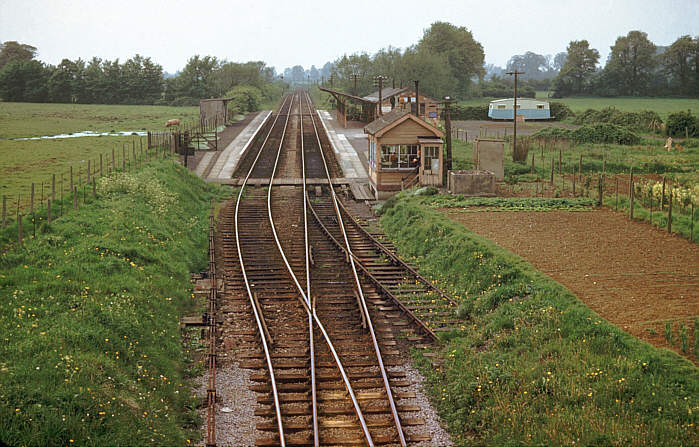
|
|
An excellent early 1960s view of Carterton station from the road overbridge. Note the two fenced footpath approaches, that on the left conventionally follows the edge of the
field, while on the right, the path passes through the centre of the allotments. Contrast that with the view from the same spot on 12 November 2005 (hover your mouse over the picture).
Colour Rail & Martin Loader Past and Present Photo |
|
Carterton station pictured after closure and while in use as a pigsty. I would estimate that this photo is taken around 1970, give or take a couple of years. An overgrown
trackbed suggests the track has been lifted for some time, and yet the bush growth around the signal box is not as advanced as in my 1973 photo (see below). As the platform was largely just a cinder surface the
vegetation has quickly taken hold. A line of bales, hurdles and sheets of corrugated iron are being used to form the front wall of the pig pens, allowing the porcine occupants some fresh air!
Martin Loader Collection |
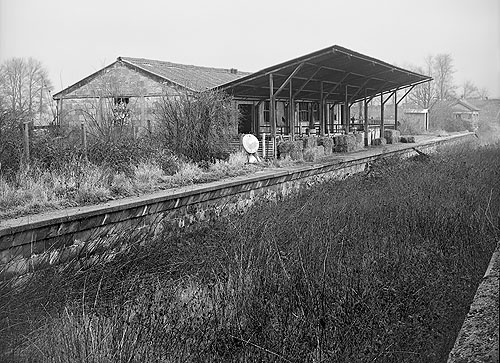
|
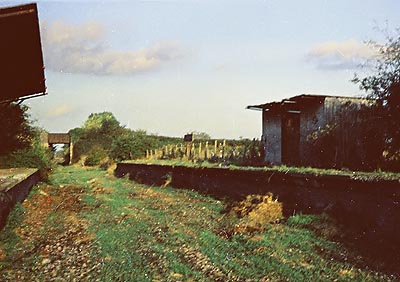 |
Carterton station on 23 October 1973. Ten years after the track was lifted little has changed, even the nameboard (missing a few letters if I remember correctly) was still
on the down platform. The crude waiting shelter and fencing were also still in situ. At this time the main building was used to house pigs, and nothing had yet been done with the area between the platforms, where the
ballast is still clearly visible. However, even by 1973 the area around the bridge had started to become choked with vegetation. Note the patch of brambles growing to the right of the bridge, already obscuring one of the
flight of steps down from the road.
Martin Loader |
|

|
|
Carriage doors open, guard looking on - the photographer just has time to get the shot of 74xx 0-6-0PT 7404 as it calls at Carterton station with the 12:44 Oxford to
Fairford service. The date is 11 June 1962, the last week of passenger services, hence the chalked inscriptions on the smokebox. Even at this late stage in the line's life, the track is
well maintained - something
which can not be said of parts of today's rail network.
Paul Strong |
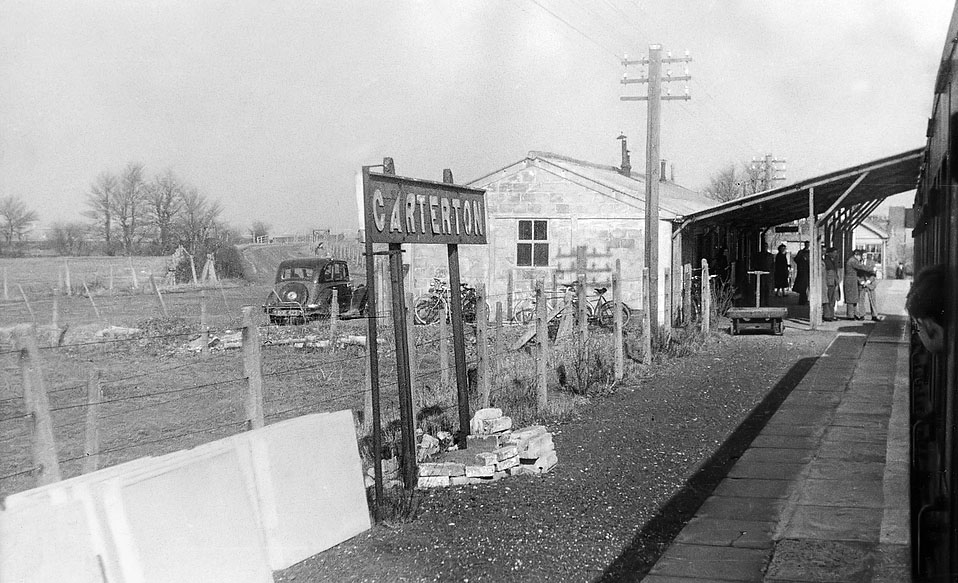 |
|
The station as seen from an Oxford bound train on 10 March 1956. The new paving stones in the foreground are not destined for the unpaved area in front of the nameboard, as
that appeared to have remained cinder covered until the line closed. Presumably they were destined for some platform edge repairs elsewhere on the station. Behind the car the approach road can be seen rising up towards the
Carterton road.
R.M.Casserley
|
 |
The signal box at Carterton was unique on the Fairford Branch in not being situated on the station platform. The two views above, taken on 8 March 1980, show the structure
jacked up prior to removal to the Swindon & Cricklade Railway. A month later it still hadn't moved and the opportunity was taken (left) to get a signalman's view along the old trackbed towards the bridge! The two upper
views show that even in its dilapidated state details of the paint scheme can still be seen. Marks visible on the rear of the box betray the location of the battery boxes for the ATC equipment. The picture of the interior
(below) shows the two tone paintwork, separated by a red band. Also visible is the remains of an electrical junction box and the positions of various signaling instruments. The main block instruments were on a long shelf
in front of the windows.
Martin Loader
|
|
Carterton's unconventionally styled station somehow reflected the character of the town itself. Set against the background of typical Upper Thames and Cotswold villages,
Carterton is something of a surprise, more reminiscent of the suburban sprawl of places such as Aldershot, or with its wide verges and well spaced properties (at least before modern infill building), small town USA. The
town owes its origins and name to William Carter, who purchased Rock Farm and surrounding land for £8,880 and divided it up into smallholdings. The town quickly prospered, and the building of nearby RAF Brize Norton
in the late 1930s ensured further expansion.
|
|
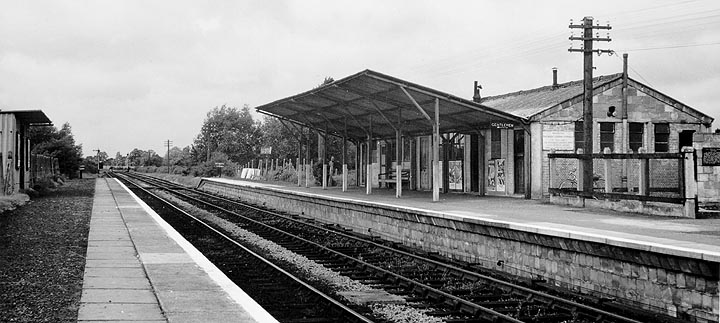
|
|
Carterton station is seen here in July 1956, looking towards Alvescot. The down platform waiting shelter can be seen on the left, while this view also clearly shows the
construction details of the canopy on the up platform. The notice on the end of the building warns about the fragile nature of the roof, and suggests the use of duck boards or roof ladders. This notice survived until
the 1980 modernisation (see below).
Martin Loader Collection
|
|
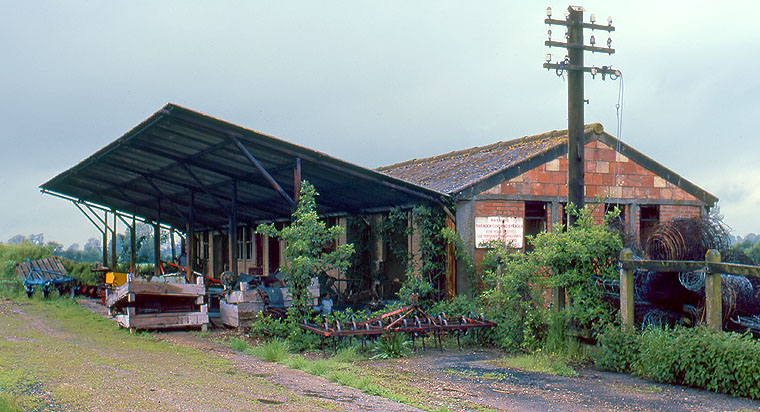
|
|
Carterton station pictured on 26 May 1979. After having been used as a pigsty for a few years, at this time it was just used as a general store. Note that apart from
filling in the area where the tracks were, up to platform level, very little has changed since the 1950s view (above). The fence and even the telegraph pole survive. Nature was starting to take over, but that was very
soon to change (see below).
Martin Loader |
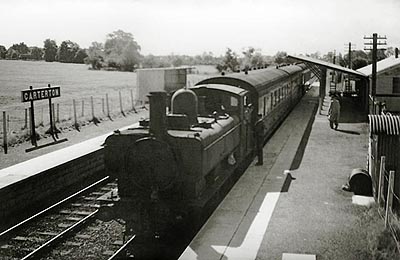 |
74xx 0-6-0PT 7404 waits at Carterton station with what is probably the 13:50 Fairford to Oxford train sometime in the mid 1950s. Having only traveled ¾ mile from Alvescot
the loco would have had to begun slowing for the station stop as soon as it had reached line speed! This view shows the corrugated iron cycle shed on the up platform, and the austere down platform shelter above the
locomotive. Signalman Percy Bowl can be seen exchanging tokens with the driver.
Jim Barton Collection |
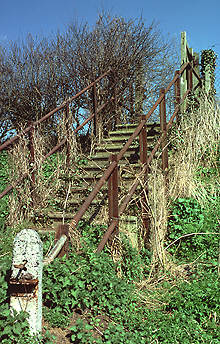 |
|
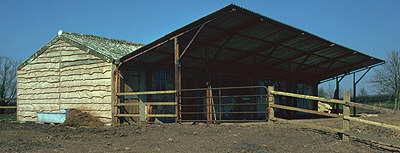
|
|
In preparation for its new role as a riding stables, the station building received some rustic cladding in 1980, although otherwise externally it remains unchanged.
Ironically this austere wartime building now has the honour of being the sole surviving Fairford Branch Line station building. The small shelter on the down platform was removed in the mid 1970s.
Martin Loader
|
|
Pedestrian access to the platforms at Carterton was by means of flights of steps from the road above. On 5 April 1980 the concrete steps leading to the up platform
were still clearly visible, along with the gate onto the roadway. Today however, an impenetrable jungle of vegetation has obscured this view.
Martin Loader |
|
|
Single to Fairford please! Despite seeing its last passenger nearly 60 years ago, and being used as a riding stables for the last 40 years, which itself involved considerable
modification from its interim use as a pig farm and general farm machinery store, the ticket window still survives at Carterton station. On 12 November 2005 it is pictured looking from the waiting room side into the ticket
office. The black and white paintwork is obviously new, but the cheap block construction of the building is still evident. Despite the crude construction, the building has stood the test of time well, and while virtually
everything else connected with the line apart from the bridges and the trackbed itself have been swept away, Carterton station building looks set to have an assured future.
Martin Loader (with permission) |
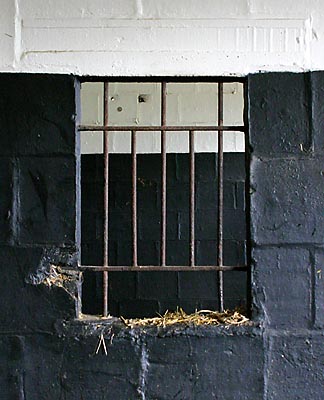
|
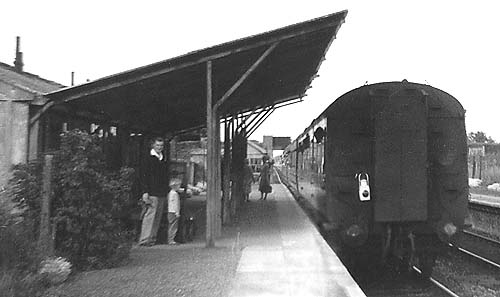 |
On the last day of passenger services (16 June 1962), a Fairford to Oxford service pulls out of Carterton station leaving a small group of passengers on the platform (left). I
am the young lad standing with his father under the awning and while dad is more concerned with my brother taking the photograph, I am only interested in the departing train (some things never change!). Over 43 years later,
on 12 November 2005, I stood in exactly the same spot to take the picture of the station building as it is now (above), while one of the building's equine occupants looks on.
Robert Loader & Martin Loader
|
|
Leaving Carterton station the line continues in a straight line for a further ¼ mile before curving very slightly onto a south westerly course, again resuming a perfectly
straight course before reaching the next station, Alvescot. Shortly after leaving Carterton another small stream was crossed on a 4 ft stone arch (SP285048), however, as can be seen from the photograph below, this area
has now been incorporated into the adjoining fields and the stream culverted.
|
|
A short distance from Carterton station the line crossed the Shill Brook (SP284047). Along with the Rivers Evenlode, Windrush & Leach, one of the more substantial
watercourses encountered on the route. This view (right) on 6 December 2005, shows the bridge with Carterton station in the distance. As can be seen the bridge is now used for field access and has an extremely rustic
additional fence and gates at either end. The original bridge was constructed entirely of timber, and indeed remains of the timber piling can still be seen in the water even today. The present bridge has timber decking
carried on substantial steel girder beams. A short distance further on another small stream is crossed, the original 3 ft brick arch being still in place.
Martin Loader |
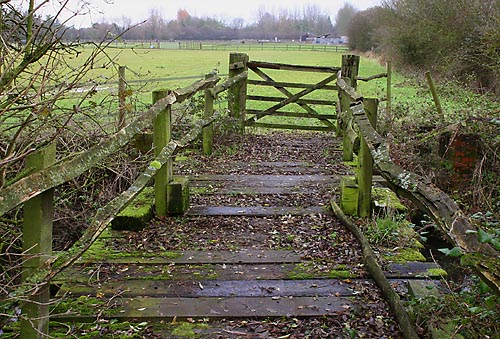
|
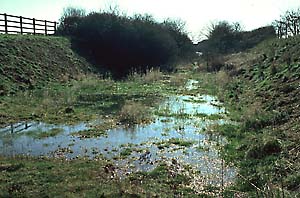 |
Railway or canal? The East Gloucestershire Railway passed through relatively flat countryside and had few earthworks. However, approaching Alvescot the line passed through a
shallow cutting (SP279043), which as can be seen from this April 1980 picture was prone to flooding. Just before this cutting there are a series of nine 1 ft earthenware pipe drains under the line (mostly still visible),
some only a few yards apart, presumably intended to prevent flooding in the nearby fields.
Martin Loader |
|